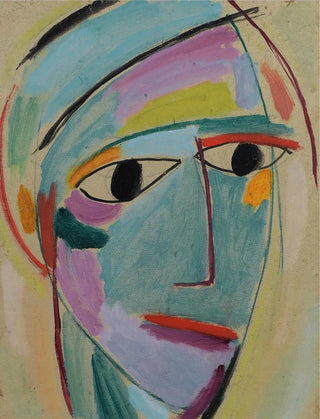Art print | Mystical head three-quarter profile - Alexej von Jawlensky


View from behind

Frame (optional)
Alexej von Jawlensky’s “Mystic Head Three-Quarter Profile” is a piece that transcends mere portraiture to immerse viewers in a universe of vibrant colors and suggestive forms. This artwork, emblematic of the Expressionist movement, invites deep contemplation, revealing not only an individual’s face but also the human soul in all its complexity. Through its stylized features and bold nuances, Jawlensky captures the very essence of being, hinting at a spiritual dimension beyond the visible. The art print of this piece offers a unique opportunity to immerse oneself in the emotional intensity and aesthetic richness that characterize this major artist’s work.
Style and uniqueness of the work
Jawlensky’s style is distinguished by its innovative approach to portraiture, blending abstraction and figuration. In "Mystic Head Three-Quarter Profile," the contours of the face are both defined and blurred, creating an impression of evanescence that draws the eye. The colors, carefully chosen, oscillate between warm and cool tones, evoking a dialogue between light and shadow. This dynamic chromatic palette contributes to a sense of depth and movement, as if the depicted face is coming to life before the viewer’s eyes. Jawlensky’s use of color to express emotions rather than physical realities is a signature of his work, making each art print unique and deeply personal. The “Mystic Head” does not escape this rule, offering a visual experience that invites reflection and interpretation.
The artist and his influence
Alexej von Jawlensky, an emblematic figure of the early 20th century, established himself as a pioneer of expressionism. Born in Russia, he migrated to Germany where he found fertile ground to develop his art. Influenced by the artistic currents of his time, including Fauvism and Cubism, Jawlensky created a visual language that is uniquely his own, combining spirituality and modernity. His exploration of psychological and emotional themes through portraiture paved the way for

Matte finish

View from behind

Frame (optional)
Alexej von Jawlensky’s “Mystic Head Three-Quarter Profile” is a piece that transcends mere portraiture to immerse viewers in a universe of vibrant colors and suggestive forms. This artwork, emblematic of the Expressionist movement, invites deep contemplation, revealing not only an individual’s face but also the human soul in all its complexity. Through its stylized features and bold nuances, Jawlensky captures the very essence of being, hinting at a spiritual dimension beyond the visible. The art print of this piece offers a unique opportunity to immerse oneself in the emotional intensity and aesthetic richness that characterize this major artist’s work.
Style and uniqueness of the work
Jawlensky’s style is distinguished by its innovative approach to portraiture, blending abstraction and figuration. In "Mystic Head Three-Quarter Profile," the contours of the face are both defined and blurred, creating an impression of evanescence that draws the eye. The colors, carefully chosen, oscillate between warm and cool tones, evoking a dialogue between light and shadow. This dynamic chromatic palette contributes to a sense of depth and movement, as if the depicted face is coming to life before the viewer’s eyes. Jawlensky’s use of color to express emotions rather than physical realities is a signature of his work, making each art print unique and deeply personal. The “Mystic Head” does not escape this rule, offering a visual experience that invites reflection and interpretation.
The artist and his influence
Alexej von Jawlensky, an emblematic figure of the early 20th century, established himself as a pioneer of expressionism. Born in Russia, he migrated to Germany where he found fertile ground to develop his art. Influenced by the artistic currents of his time, including Fauvism and Cubism, Jawlensky created a visual language that is uniquely his own, combining spirituality and modernity. His exploration of psychological and emotional themes through portraiture paved the way for






